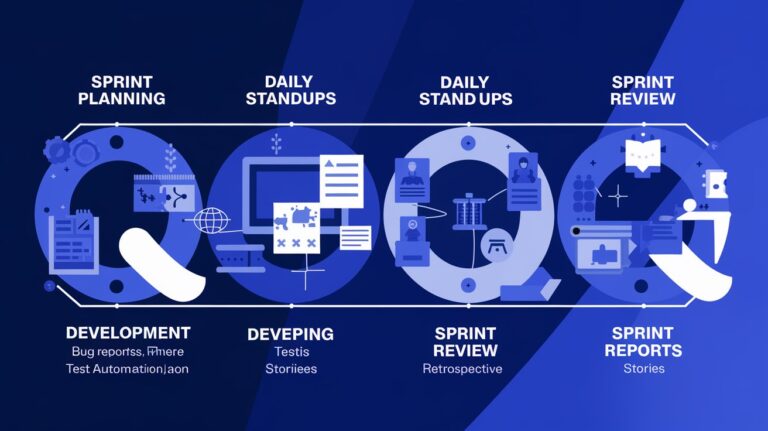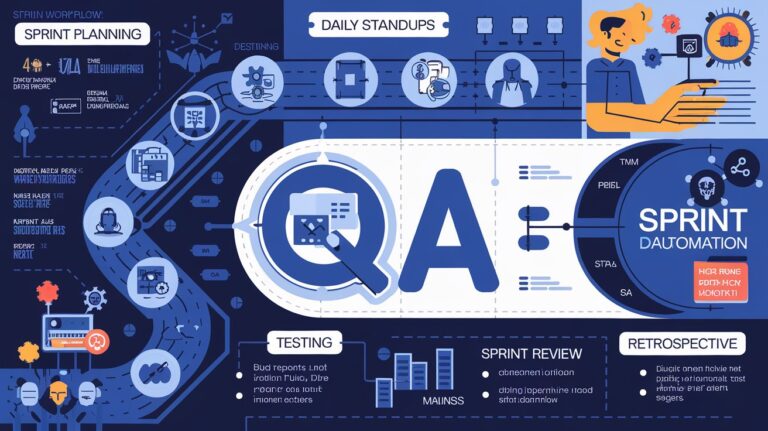In today’s fast-paced software development landscape, Agile methodologies have become the standard, with Scrum leading the charge. But while Scrum is often discussed from the perspective of developers and product owners, Quality Assurance (QA) professionals play a critical role in the success of Agile teams. This article explores how QA teams can thrive in Scrum environments by enhancing collaboration, improving testing workflows, and delivering higher quality software.
Table of Content

What is Scrum and How Does QA Fit In?
Key Benefits of Scrum for QA Teams
Implementing Scrum Best Practices for QA Teams
Common Challenges for QA in Scrum—and How to Overcome Them
How Scrum Transformed QA Collaboration
Final Thoughts
What is Scrum and How Does QA Fit In?

Scrum is an Agile framework designed to help teams deliver value in a fast and flexible way. It emphasizes short development cycles (sprints), continuous feedback, and team collaboration. The core Scrum roles include the Product Owner, Scrum Master, and Development Team. Traditionally, QA teams worked in silos, often joining the process near the end of the software development lifecycle. However, in Scrum, QA is integrated from day one.
Instead of acting as gatekeepers, QA professionals become quality advocates—actively participating in sprint planning, daily stand-ups, and retrospectives. This shift not only improves software quality but also fosters cross-functional team collaboration.
Key Benefits of Scrum for QA Teams

1. Early Involvement in the Development Process
Scrum allows QA teams to be involved right from the planning stages. By understanding business requirements early, testers can identify potential edge cases, define test strategies, and prepare automation scripts before development begins.
2. Improved Communication and Collaboration
In Scrum, QA professionals work alongside developers and product owners. Daily stand-ups encourage open dialogue, helping teams catch issues early and resolve blockers quickly. This constant interaction ensures QA efforts align with development goals.
3. Faster Feedback Loops
One of the biggest advantages of Scrum is its short feedback cycle. QA teams can execute automated and manual tests in real-time, often during the same sprint. Bugs are detected and fixed faster, leading to better sprint outcomes and fewer regressions.
4. Increased Test Coverage through Automation
Agile encourages the use of automation, particularly for regression and integration testing. QA teams in Scrum can collaborate with developers to create testable code and leverage continuous integration tools to run automated test suites efficiently.
5. Continuous Improvement Through Retrospectives
Scrum retrospectives offer QA teams a platform to discuss what went well, what didn’t, and what can be improved. Whether it’s improving test case documentation or refining bug-reporting processes, QA can drive continuous process enhancements.
Implementing Scrum Best Practices for QA Teams

To maximize the benefits of Scrum, QA teams must adopt specific strategies and best practices tailored to Agile workflows.
1. Participate in All Scrum Ceremonies
QA professionals should actively engage in sprint planning, daily stand-ups, sprint reviews, and retrospectives. This ensures they stay aligned with the team’s objectives and can raise potential risks early.
2. Write Test Cases During Sprint Planning
By collaborating with developers and product owners, QA can write meaningful and effective test cases that reflect user stories and acceptance criteria. This helps streamline the testing process during the sprint.
3. Adopt a Shift-Left Testing Approach
Shift-left testing involves testing earlier in the development lifecycle. In Scrum, this means validating requirements, performing static code analysis, and running unit tests before integration begins.
4. Use Agile Testing Quadrants
Agile testing quadrants help QA teams balance different testing types: unit, integration, performance, and exploratory testing. This framework ensures comprehensive coverage and better risk management.
5. Leverage Test Automation and CI/CD
Implementing test automation frameworks like Selenium, Cypress, or Playwright can help QA teams run repetitive tests efficiently. When integrated with CI/CD tools like Jenkins or GitHub Actions, QA can ensure that every code change is tested instantly.
Common Challenges for QA in Scrum—and How to Overcome Them

Even with all its benefits, QA teams may face unique challenges in Scrum environments:
1. Unclear Requirements
When user stories lack clarity, testers struggle to define test cases. To counter this, QA should work closely with product owners during backlog grooming and request clear acceptance criteria.
2. Last-Minute Changes
Agile teams must be flexible, but frequent changes can disrupt test planning. Maintaining modular and reusable test scripts, especially in automation, helps mitigate this issue.
3. Time Constraints
With fixed sprint durations, QA often has limited time to test. Risk-based testing, prioritizing critical paths, and automating repetitive tasks can help optimize time usage.
How Scrum Transformed QA Collaboration

Consider a mid-sized SaaS company that adopted Scrum but initially excluded QA from sprint planning. The QA team often received stories late, leading to missed bugs and bottlenecks. After restructuring, QA joined planning meetings, wrote acceptance criteria, and co-developed automated test scripts with developers. Within two months, the defect leakage rate dropped by 40%, and customer satisfaction increased significantly.
Final Thoughts

QA is no longer just about finding bugs—it’s about preventing them, promoting quality, and ensuring user satisfaction. By embedding QA deeply into Scrum processes, organizations can build better software, faster. The collaboration between QA, developers, and product owners becomes the foundation for innovation and efficiency.
If you’re a QA professional or team lead, embracing Scrum practices can elevate your testing capabilities and make you an integral part of your Agile team’s success.















